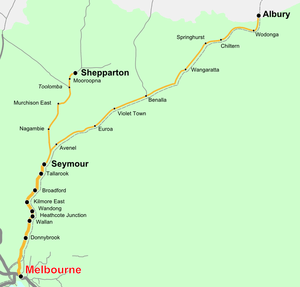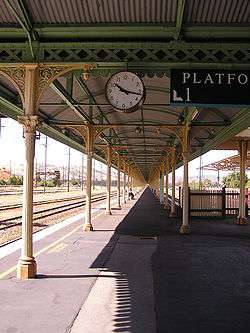North East railway line
| North East railway line, Victoria | |
|---|---|
 | |
| Line details | |
| Commenced | 1860 |
| Completed | 1883 |
| Tracks | 1,600 mm (5 ft 3 in) (Broad gauge) double track Melbourne - Seymour, single track to Shepparton; 1,435 mm (4 ft 8 1⁄2 in) standard gauge single track Melbourne - Seymour, double track to Albury |
| Used by |
Broad gauge: V/Line passenger trains and intrastate freight. Standard gauge: V/Line and CountryLink passenger trains and interstate freight |
| Connections | Seymour and Shepparton lines |
| Rail transport in Victoria | |
The North East railway is in the north-east of Victoria, Australia.[1] From the state capital Melbourne to the New South Wales Main South Line at Albury, via Seymour, Benalla, Wangaratta and Wodonga. It is a key component of the Sydney–Melbourne rail corridor.
Services
On the broad-gauge line, Metro Trains Melbourne operates suburban passenger trains along the inner section of the line as the Craigieburn line, and V/Line operates the interurban Seymour and Shepparton lines. Freight services are operated by Pacific National.
On the standard-gauge line, NSW TrainLink XPT trains to Sydney and V/Line trains to Albury run, and interstate freight by Aurizon and Pacific National.
Between Melbourne and Seymour the route consists of two broad gauge tracks with a single standard gauge track alongside. North of Seymour, the broad gauge line branches to Shepparton and two standard gauge tracks continue to Albury. All lines are owned by VicTrack, the broad gauge line managed by V/Line, the standard gauge line by the Australian Rail Track Corporation.[2]
History




The Melbourne and Essendon Railway Company opened the first section of the Albury line, from North Melbourne to Essendon, in 1860.[3] Following its takeover by the Victorian Government in 1867, the line was extended by 1872[4] to School House Lane on the south side of the Goulburn River near Seymour, and later that year to Seymour and then to Longwood. Benalla, Wangaratta, Springhurst and Wodonga were reached in 1873,[3] connecting with the New South Wales Government Railways at Albury at a break of gauge in 1883. The design engineer was Robert Watson.
Construction of a standard gauge track parallel with the broad gauge from Albury to Melbourne commenced in 1959, completing the Sydney-Melbourne railway.[5] The first freight train operated on 3 January 1962,[6] the first passenger train on 16 April.[5]
The line was used by prestige passenger services between the state capitals of Melbourne and Sydney, including the Sydney Limited, Spirit of Progress, Southern Aurora, and Intercapital Daylight; but due to declining patronage they were replaced by the XPT from the 1990s.
Maintaining two parallel railways has drawn criticism, including inefficiencies in maintaining track, operating trains, and duplicated train control centres.[7] By 2001 the State Government announced the conversion of the broad gauge line to standard,[8] but action was stifled due largely to complex leasing arrangements. Speed restrictions had been applied to the broad gauge line due to track deterioration.[9]
In May 2008 it was announced that the line would be upgraded, with the conversion of 200 kilometres (120 mi) of broad gauge track to standard gauge between Seymour and Albury, a 5 km (3.1 mi) bypass around Wodonga, and upgrades between Melbourne and Seymour including new passing loops.[10] Passenger platforms were to be built on the standard-gauge line, and V/Line locomotives and carriages converted to operate on the line. Costing A$501.3 million, the Victorian Government was to contribute A$171.3 million, the Australian Government A$45 million for the Wodonga Rail Bypass, and the Australian Rail Track Corporation A$285 million and take responsibility for the standard-gauge line under a 45-year lease from Victoria.[11] The project was due for completion by 2010, with passenger services disrupted for up to 12 months.[12]
On 8 November 2008, broad gauge passenger trains ceased after the evening V/Line service from Melbourne to Albury and a special train operated by the Seymour Railway Heritage Centre, the final broad-gauge passenger train from Albury to Melbourne.[13][14] In December 2008 standardisation works commenced, contracted by ARTC to the Southern Improvement Alliance. The first train on the Wodonga Rail Bypass was in March 2010.[15]
In early August 2010 CountryLink decided to terminate all Sydney-Melbourne XPTs at Albury for an indefinite length of time, due to defects in the newly resleepered track. "Mud holes" resulted in speed restrictions on more than 200 kilometres (about 66 per cent) of the line, adding an extra 1.5 hours to the travelling time.[16] Train drivers have blamed the ARTC's $285 million concrete sleeper project for the track issues, stating that the incorrect insertion of 300,000 new concrete sleepers is to blame. They have repeatedly reported freight trains breaking couplings due to the rough track.[17] CountryLink trains resumed in mid September 2010, V/Line trains the following year.[18]
Branch lines south of Seymour
A branch line opened from Heathcote Junction (near Kilmore) to Kilmore in 1888 and to Tooborac in 1890, connecting with a line from Bendigo and Heathcote opened a little earlier. The Heathcote Junction – Heathcote line closed in 1968. A branch line from Kilmore to Lancefield opened in 1892, closed in 1904.
The Mansfield line opened from Tallarook to Yea in 1883, Molesworth in 1889, Cathkin and Merton in 1890 and Mansfield in 1891. It is now closed. A branch line was built from Cathkin to Koriella in 1890 and Alexandra in 1909. This line closed in 1978.
Branch lines north of Seymour
The Shepparton line opened from Mangalore to Toolamba and Shepparton in 1880.
A branch line opened from Benalla to St James in 1883, Yarrawonga in 1886 and Oaklands in 1938, with a break of gauge there until the State Rail Authority line closed south of Boree Creek. A short branch line was built from Benalla to Tatong in 1914, closed in 1947.
The narrow-gauge Whitfield branch line opened from Wangaratta to Whitfield in 1899, closing in 1953.
Branch lines opened from Bowser (north of Wangaratta) to Everton in 1875, extended to Beechworth in 1876 and Yackandandah in 1891. The line closed in 1954. The Bowser – Everton line was extended to Myrtleford in 1883 and Bright in 1890, now closed. A short line to Peechelba East also branched from Bowser
A short branch line opened from Springhurst via Rutherglen to Wahgunyah in 1879. Services were suspended in 1995.
A branch line opened from Wodonga to Tallangatta between 1889 and 1891, Shelley in 1916, Beetoomba in 1919 and Cudgewa in 1921.[19] A connection from Albury was added near Wodonga, creating a turning triangle to enable the Sydney Limited and its successor Spirit of Progress with their observation cars to be turned as complete trains. The line closed beyond Bandiana in 1981,[5] and the connection to Wodonga later removed, with only standard gauge traffic continuing to use the line via Albury.[20]
Line guide





Bold stations are termini, italic stations are staffed at least part-time. Broad gauge, 1,600 mm (5 ft 3 in), is in red, standard gauge, 1,435 mm (4 ft 8 1⁄2 in), in blue.
North East railway | ||||||||||||||||||||||||||||||||||||||||||||||||||||||||||||||||||||||||||||||||||||||||||||||||||||||||||||||||||||||||||||||||||||||||||||||||||||||||||||||||||||||||||||||||||||||||||||||||||||||||||||||||||||||||||||||||||||||||||||||||||||||||||||||||||||||||||||||||||||||||||||||||||||||||||||||||||||||||||||||||||||||||||||||||||||||||||||||||||||||||||||||||||||||||||||||||||||||||||||||||||||||||||||||||||||||||||||||||||||||||||||||||||||||||||||||||||||||||||||||||||||||||||||||||||||||||||||||||||||||||||||||||||||||||||||||||||||
|---|---|---|---|---|---|---|---|---|---|---|---|---|---|---|---|---|---|---|---|---|---|---|---|---|---|---|---|---|---|---|---|---|---|---|---|---|---|---|---|---|---|---|---|---|---|---|---|---|---|---|---|---|---|---|---|---|---|---|---|---|---|---|---|---|---|---|---|---|---|---|---|---|---|---|---|---|---|---|---|---|---|---|---|---|---|---|---|---|---|---|---|---|---|---|---|---|---|---|---|---|---|---|---|---|---|---|---|---|---|---|---|---|---|---|---|---|---|---|---|---|---|---|---|---|---|---|---|---|---|---|---|---|---|---|---|---|---|---|---|---|---|---|---|---|---|---|---|---|---|---|---|---|---|---|---|---|---|---|---|---|---|---|---|---|---|---|---|---|---|---|---|---|---|---|---|---|---|---|---|---|---|---|---|---|---|---|---|---|---|---|---|---|---|---|---|---|---|---|---|---|---|---|---|---|---|---|---|---|---|---|---|---|---|---|---|---|---|---|---|---|---|---|---|---|---|---|---|---|---|---|---|---|---|---|---|---|---|---|---|---|---|---|---|---|---|---|---|---|---|---|---|---|---|---|---|---|---|---|---|---|---|---|---|---|---|---|---|---|---|---|---|---|---|---|---|---|---|---|---|---|---|---|---|---|---|---|---|---|---|---|---|---|---|---|---|---|---|---|---|---|---|---|---|---|---|---|---|---|---|---|---|---|---|---|---|---|---|---|---|---|---|---|---|---|---|---|---|---|---|---|---|---|---|---|---|---|---|---|---|---|---|---|---|---|---|---|---|---|---|---|---|---|---|---|---|---|---|---|---|---|---|---|---|---|---|---|---|---|---|---|---|---|---|---|---|---|---|---|---|---|---|---|---|---|---|---|---|---|---|---|---|---|---|---|---|---|---|---|---|---|---|---|---|---|---|---|---|---|---|---|---|---|---|---|---|---|---|---|---|---|---|---|---|---|---|---|---|---|---|---|---|---|---|---|---|---|---|---|---|---|---|---|---|---|---|---|---|---|---|---|---|---|---|---|---|---|---|---|---|---|---|---|---|---|---|---|---|---|---|---|---|---|---|---|---|---|---|---|---|---|---|---|---|---|---|---|---|---|---|---|---|---|---|---|---|---|---|---|---|---|---|---|---|---|---|---|---|---|---|---|---|---|---|---|---|---|---|---|---|---|---|---|---|---|---|---|---|---|---|---|---|---|---|---|---|---|---|---|---|---|---|---|---|---|---|---|---|---|
Legend
| ||||||||||||||||||||||||||||||||||||||||||||||||||||||||||||||||||||||||||||||||||||||||||||||||||||||||||||||||||||||||||||||||||||||||||||||||||||||||||||||||||||||||||||||||||||||||||||||||||||||||||||||||||||||||||||||||||||||||||||||||||||||||||||||||||||||||||||||||||||||||||||||||||||||||||||||||||||||||||||||||||||||||||||||||||||||||||||||||||||||||||||||||||||||||||||||||||||||||||||||||||||||||||||||||||||||||||||||||||||||||||||||||||||||||||||||||||||||||||||||||||||||||||||||||||||||||||||||||||||||||||||||||||||||||||||||||||||
References
- ↑ Turton, Keith W. (1973). The North East Railway. (A Lineside Guide) Melbourne to Wodonga. Australian Railway Historical Society (Victorian Division). ISBN 0-85849-013-7.
- ↑ "Background - Organisation of Australia's Railways". Department of Transport and Regional Services. Retrieved 2008-03-03.
- 1 2 Sid Brown (March 1990). "Tracks Across the State". Newsrail. Vol. 18 no. 3 (Australian Railway Historical Society (Victorian Division)). pp. 71–76.
- ↑ The Centenary of the Opening of the Railway to Seymour Turton, Keith W. Australian Railway Historical Society Bulletin, April;May 1972 pp73-95;101-109
- 1 2 3 "VR timeline". http://www.victorianrailways.net/. Mark Bau. Retrieved 2008-03-03. External link in
|work=(help) - ↑ Australian Railway Historical Society Bulletin, March 1962 pp35-39
- ↑ "Derailment of Freight Train 1SP2N and the Subsequent Collision of Passenger Train 8318". Australian Transport Safety Bureau: Investigation Reports. 1 November 2006. Retrieved 2008-03-03.
- ↑ Victorian Auditor General (August 2006). "Rail Gauge Standardisation Project". Victorian Auditor General's Office. Retrieved 2008-02-08.
- ↑ V/Line: V/Line Voice Issue 32, February 2008
- ↑ "$500m rail link upgrade for Victoria". news.ninemsn.com.au. Retrieved 2008-05-30.
- ↑ "Premier of Victoria, Australia - FEDERAL-STATE CO-OPERATION DELIVERS MAJOR RAIL PROJECT". www.premier.vic.gov.au. Retrieved 2008-05-30.
- ↑ "Full steam ahead - ABC News (Australian Broadcasting Corporation)". www.abc.net.au. Retrieved 2008-05-30.
- ↑ Victoria MacDonald (2008-11-08). "Historic day as a railway era comes to an end". The Border Mail (Albury-Wodonga: Fairfax Media).
- ↑ "Seymour Railway Heritage Centre - Tours 2008 - The Last Broad Gauge Passenger Train from Albury". Seymour Railway Heritage Centre. Retrieved 2008-11-09.
- ↑ VICTORIA MACDONALD (16 March 2010). "A bypass milestone as freight train ambles in". The Border Mail. www.bordermail.com.au. Retrieved 2010-03-16.
- ↑ BRAD WORRALL (10 August 2010). "XPT passengers forced onto buses". The Border Mail. www.bordermail.com.au. Retrieved 2010-09-14.
- ↑ BRAD WORRALL (11 August 2010). "V/line mud 'chaos'". The Border Mail. www.bordermail.com.au. Retrieved 2010-09-14.
- ↑ BRAD WORRALL (13 September 2010). "Trains back on track". Prime Wodonga. wodonga.iprime.com.au. Retrieved 2010-09-14.
- ↑ Australian Railway Historical Society Bulletin, June 1960 pp91-93
- ↑ "Cudgewa Line". www.vicrailstations.net. Retrieved 2008-06-09.
Further reading
- Turton, Keith W. (1973). The North East Railway. (A Lineside Guide) Melbourne to Wodonga. Australian Railway Historical Society (Victorian Division). ISBN 0-85849-013-7.
- John C. Jennings and Robert K. Whitehead (July 2005). Seymour - A Railway Town. Seymour and District Historical Society. ISBN 0-9751658-0-1.
- Turton, Keith W. (1973). Six And A Half Inches From Destiny. The first hundred years of the Melbourne-Wodonga Railway 1873-1973. Australian Railway Historical Society (Victorian Division). ISBN 0-85849-012-9.
- Covell, C.M. (November 1967). "Some Impressions and Reflections of the North-Eastern Line". Australian Railway Historical Society Bulletin. pp. 230–244.
External links
- Statistics and detailed schematic map at the vicsig enthusiast website
- History Victoria: The North East Railway Story
| ||||||||||||||||||||||||||||||||||||||
